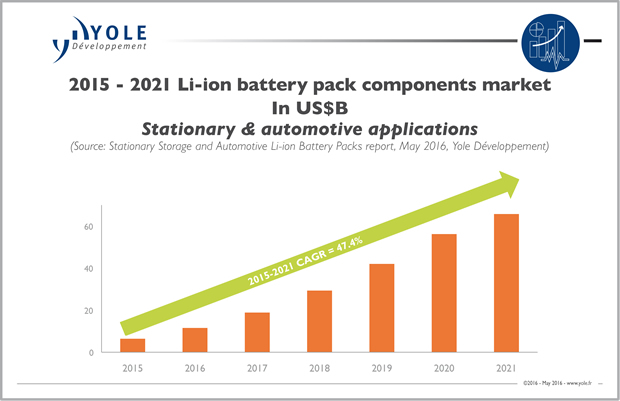Technologies for automotive lighting: a deep mutation
After a slow increase of revenue from 2015 to 2018 due to LED cost erosion, Yole Développement’s analysts forecast a market recovery with a 23.7% CAGR between 2015 and 2021. This trends is explained by the wider adoption of advanced front lighting systems and the slow adoption of emerging light sources such as laser and OLED.
Laser technology is just at the starting point in term of adoption: there are still some questions about technology’s added-value and potential associated risks. From its side, OLED technology confirms its added-value but suffers from its very high price.
Under its latest report, Automotive Lighting: Technology, Industry & Market Trends, the 'More than Moore' market research and strategy consulting is analysing the market potential of both technologies. This new analysis presents the current status and future trends of the automotive lighting market. The market research reviews the industry structure, the technologies developed for automotive lighting and related roadmaps. The integration of new lighting technologies is transforming automotive lighting systems and their applications, offering more design flexibility, increased efficacy, and new functionalities.
LEDs are rapidly gaining popularity as their cost decreases and performance increases (i.e. efficiency, luminance, package size). For example, full LED headlamps that first saw commercialisation in 2008 on luxury cars like the V10 Audi R8 have since penetrated the C-segment vehicle market in 2012, and are now being commercialised in emerging markets. Nowadays, nearly all Tier-1s have developed full LED-based headlamp systems.
LED sources offer very high efficiency and high luminance in a small package, allowing new design possibilities and increased light beam control. “These sources are revolutionising automotive lighting, offering more design flexibility and increased efficacy, and allowing for new functionalities”, comments Pierric Boulay, Technology & Market Analyst at Yole.
Laser and OLED sources are still emerging technologies: laser solutions are just being implemented in commercial vehicles. And several questions remain about the technology’s added value and potential associated risks. In parallel, OLED technology provides strong added-value at a design level but still suffers from its very high price. Yole’s analysts list the following examples:
- The first commercial car (BMW i8) with laser-based headlamps was unveiled in autumn 2014.
- The first commercial car (BMW M4 GTS) with OLED-based RCL was unveiled in autumn 2015.
“OLED technology represents a big opportunity for interior and exterior lighting but this technology need to be more affordable and reliable”, explains Pars Mukish, Business Manager, LED, OLED and sapphire activities at Yole. “At the middle term, we expect OLED technology to start spreading across various interior lighting functions and accessing some new exterior lighting functions”. Adoption of OLED in RCL will match with a design shift from 2D to 3D light source, made possible by the nature of the OLED device itself: thin, bendable, and a large emitting surface source. However, both technologies have price and technological issues that must be solved in order to match with automotive OEM requirements like reliability and lifetime.
From their side, laser-based headlamps could enable long-distance night vision: according to Yole’s report, distances could reach up to 600m. Such technology combines light performance (Xenon source) with design possibilities offered by LEDs.
With the implementation of this solution within their product portfolio, car makers promote their brand and demonstrate their commitment to innovation and improvement.
Today laser diode suppliers are limited. Indeed, according to Yole, only 3 companies seem to work on laser-based products. They are: Osram, Nichia and Soraa.
“Laser headlamps have a great potential but some issues have to be solved to enable a large adoption”, comments Pierrick Boulay from Yole. And he details: “Laser performances are limited due to a problem of high temperature. Reliability is also narrow because of phosphor performances. Human safety is an important concern due to the risk of direct contact with human eye... Consequently, at Yole, we think that laser sources will focus on luxury and premium cars for a long period. Such systems will require strong cost decrease prior accessing other vehicle segments.”

Integration of these new semiconductor/electronic-based components is also enabling the realisation of full electronic systems including solid state light, sensor and software, and by extension the development of advanced lighting functionalities. The main objective of these functionalities is to offer beam patterns that automatically adjust to the driving environment. More recently, the use of matrix LED systems combined with camera and image processing functions has allowed for creation of new lighting functions like adaptive front lighting and glare-free lighting. However, these combinations make the development of such systems more difficult, and require the development of new know-how. Indeed, reliable and dynamic systems induce strong expertise in domains like lighting, thermal management, sensor, and data processing.


